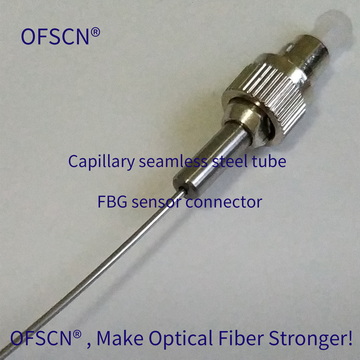Temperature monitoring is a crucial aspect of nuclear power plant safety. The accurate and reliable measurement of temperature is required to ensure the safe and efficient operation of a nuclear reactor. Fiber grating sensing technology has emerged as a promising solution for temperature monitoring in nuclear reactors. In this article, we will discuss the problems that fiber grating sensing technology can solve, and how Beijing Dacheng Yongsheng Technology Co., Ltd.(short for DCYS ) can support the temperature monitoring of nuclear reactors in the nuclear power field.
Fiber Bragg Grating Sensing Principle:
Fiber Bragg gratings (FBGs) are periodic structures that are inscribed in the core of an optical fiber. These structures reflect a specific wavelength of light that is determined by the periodicity of the grating. When the grating is subjected to mechanical or thermal strain, the reflected wavelength changes in a predictable manner. By monitoring the reflected wavelength, changes in strain, temperature, and other parameters can be detected. FBG sensors can be used to monitor a wide range of parameters, including strain, stress, temperature, and vibration.
Click the link below for more details:
Demand Analysis for Temperature Monitoring of Nuclear Reactors:
Temperature monitoring is essential for the safe and efficient operation of nuclear reactors. Accurate temperature measurements are required to ensure that the reactor is operating within safe temperature limits. Temperature monitoring is also necessary for optimizing the reactor's performance and preventing damage to critical components.

Why Temperature Monitoring of Nuclear Reactors is Needed:
Temperature monitoring of nuclear reactors is required to ensure the safety of the reactor and prevent accidents. Excessive temperatures can cause damage to critical components, leading to equipment failure and possible radiation leaks. Accurate temperature monitoring is also necessary for optimizing the reactor's performance and improving its efficiency.

Difficulties in Temperature Monitoring of Nuclear Reactors:
Temperature monitoring in nuclear reactors poses several challenges. The harsh environment of a nuclear reactor can cause significant temperature variations, making accurate temperature measurements difficult. The presence of high levels of radiation can also interfere with temperature sensors, leading to inaccurate measurements. Additionally, traditional temperature sensors may not be able to withstand the harsh conditions in a nuclear reactor, leading to sensor failure.
Recommended fiber grating temperature sensors:
What Problems can be Solved by FBG Sensing Technology:
Fiber grating sensing technology can help address some of the challenges associated with temperature monitoring in nuclear reactors. Fiber grating sensors are immune to electromagnetic interference, making them ideal for use in high radiation environments. They are also highly accurate and can provide real-time temperature measurements, enabling early detection of potential problems. Fiber grating sensors are also capable of withstanding the harsh conditions in a nuclear reactor, ensuring long-term reliability.
Beijing Dacheng Yongsheng Technology Co., Ltd.:
Beijing Dacheng Yongsheng Technology Co., Ltd.(short for DCYS) is a professional manufacturer of fiber grating sensors, fiber grating demodulators and system software. Specializing in the production of various fiber grating sensors, including temperature, strain, stress, displacement, vibration, shape sensors, etc. DCYS also produces fiber grating demodulators, and can customize and develop related application software.
Recommended fiber grating demodulator:
Product Alias: Fiber Bragg Grating Interrogator, FBG Interrogator, FBG Sensor Interrogator, Fiber Optic Grating Interrogator, Fiber Bragg Grating Demodulator, FBG Demodulator, Fiber Optic Grating Demodulator
This product is produced by DCYS, and it is a high-speed high-frequency fiber Bragg grating demodulator(Interrogator). The fiber grating demodulator is compatible with various specifications and models of OFSCN® fiber bragg grating sensors (temperature, strain, stress FBG sensors, etc.). It features adjustable port density (4, 8, 16 channels) and high-speed high-refresh rate capabilities.
DCYS Helps to Monitor the Temperature of Nuclear Reactor in Nuclear Power Field:
DCYS can help solve some of the challenges associated with temperature monitoring of nuclear reactors and provide reliable and accurate temperature measurement solutions.

Other Points Need to Be Clarified:
Fiber grating sensing technology has many other applications in the field of nuclear power, including radiation monitoring, strain monitoring, and water level monitoring. The technology has proven to be highly effective in providing real-time data on critical parameters, improving safety, and optimizing performance. As technology continues to advance, fiber grating sensing technology will likely become an increasingly important tool in the field of nuclear power.
In conclusion, fiber grating sensing technology has emerged as a promising solution for temperature monitoring in nuclear reactors. Accurate temperature measurements are crucial for ensuring the safe and efficient operation of nuclear reactors. Fiber grating sensors are immune to electromagnetic interference, highly accurate, and capable of withstanding the harsh conditions in a nuclear reactor, making them an ideal solution for temperature monitoring. Beijing Dacheng Yongsheng Technology Co., Ltd. is a professional manufacturer of fiber grating sensors and can provide reliable and accurate temperature measurement solutions. As technology continues to advance, fiber grating sensing technology will likely become an increasingly important tool in the field of nuclear power.
